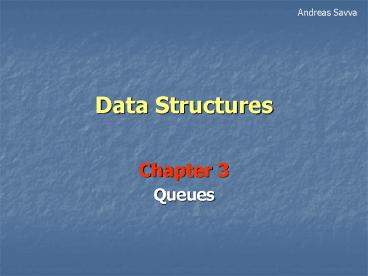Data Structures - PowerPoint PPT Presentation
1 / 33
Title:
Data Structures
Description:
Andreas Savva Data Structures Chapter 3 Queues – PowerPoint PPT presentation
Number of Views:98
Avg rating:3.0/5.0
Title: Data Structures
1
Data Structures
Andreas Savva
- Chapter 3
- Queues
2
Queues
- A data structure modeled after a line of people
waiting to be served. - The first entry which is inserted is the first
one that will be removed. (First In First Out
FIFO)
3
Application of Queuesin our everyday life
4
Application of QueuesMost common than Stacks
- Waiting for a printer
- Access to disk storage
- In a time-sharing system use of the CPU
- Along with stacks, queues are one of the simplest
data structures
5
Basic Operations for Queues
- Create a queue, leaving it empty.
- Clear the queue leaving it empty.
- Test whether the queue is Empty.
- Test whether the queue is Full.
- Return the Size of the queue.
- Retrieve the first entry of the queue, provided
the queue is not empty. - Serve remove the first entry from the queue,
provided the queue is not empty. - Retrieve and Serve retrieves and remove the
first entry from the queue, provided the queue is
not empty. - Append a new entry at the end of the queue,
provided that the queue is not full. - Print all the entries of the queue.
6
The Class Queue
class Queue
methods Queue (constructor) clear
empty full size retrieve serve
retrieve_and_serve append print Data
members
7
Stack implementation - Array
- typedef double Queue_entry
- enum Error_code success,overflow,underflow
- const int max 100
- class Queue
- public
- Queue()
- void clear()
- bool empty() const
- bool full() const
- int size() const
- Error_code retrieve(Queue_entry ) const
- Error_code serve()
- Error_code retrieve_and_serve(Queue_entry )
- Error_code append(const Queue_entry )
- void print() const
- private
- int count
- Queue_entry entrymax
8
Data Structure - Array
- front is at position 0
- rear is at position n-1
front
rear
One item
front
rear
n items
9
Create Queue
We use a constructor to initialize a new created
queue as empty.
- QueueQueue()
- // Pre None.
- // Post Initialize Queue to be empty.
entry
10
Clear
void Queueclear() // Pre None. // Post All
entries in the Queue have been // removed it is
now empty.
entry
11
Empty
bool Queueempty() const // Pre None. //
Post Return true if the Queue is
empty, // otherwise false is returned.
entry
12
Full
bool Queuefull() const // Pre None. //
Post Returns true if the Queue is
full, // otherwise false is returned.
entry
13
Size
int Queuesize() const // Pre None. //
Post Return the number of entries in the
Queue.
entry
14
Retrieve
Error_code Queueretrieve(Queue_entry item)
const // Pre None. // Post If the Queue is not
empty, the front of the queue is recorded // as
item. Otherwise an Error_code of underflow is
return.
entry
15
Serve or Dequeue
Error_code Queueserve() // Pre None. //
Post If the Queue is not empty, the front of the
Queue is removed // Otherwise an Error_code of
underflow is returned.
count
entry
16
Retrieve and Serve
Error_code Queueretrieve_and_serve(Queue_entry
item) // Pre None. // Post If the Queue is not
empty, the front of the queue is removed
and // recorded as item. Otherwise an Error_code
of underflow is return.
item
entry
A
17
Append or Enqueue
Error_code Queueappend(const Queue_entry
item) // Pre None. // Post If the Queue is not
full, item is added at the end of the
Queue. // If the Queue is full, an Error_code of
overflow is returned // and the Queue is left
unchanged.
entry
n1
18
void Queueprint() const // Pre None. //
Post Display the entries of the Queue.
19
Data Structure Circular Array
20
Queue containing one item
front
rear
Empty Queue
-1
front
rear
Queue with one empty position
front
rear
Full Queue
front
rear
21
The class Queue Circular Array
- class Queue
- public
- Queue()
- void clear()
- bool empty() const
- bool full() const
- int size() const
- Error_code retrieve(Queue_entry ) const
- Error_code serve()
- Error_code retrieve_and_serve(Queue_entry )
- Error_code append(const Queue_entry )
- void print() const
- private
- int next(int n) const
- int front, rear
- Queue_entry entrymax
22
Circular Queue
23
Create Queue
- QueueQueue()
24
Clear
void Queueclear()
rear-1
25
Empty
bool Queueempty() const
Not Empty
Empty
rear-1
26
Next position
rear
int Queuenext(int n) const
front next(front) rear next(rear) entryrear
front
27
Full
bool Queuefull() const
NOT FULL
FULL
28
Size
int Queuesize() const
max
rear front 1
29
Retrieve
Error_code Queueretrieve(Queue_entry item)
const
30
Serveor Dequeue
Error_code Queueserve()
31
RetrieveandServe
Error_code Queueretrieve_and_serve(Queue_entry
item)
32
AppendorEnqueue
rear
Error_code Queueappend(const Queue_entry
item)
33
void Queueprint() const










![Data Structures [1] PowerPoint PPT Presentation](https://s3.amazonaws.com/images.powershow.com/7170786.th0.jpg?_=20150917062)




















